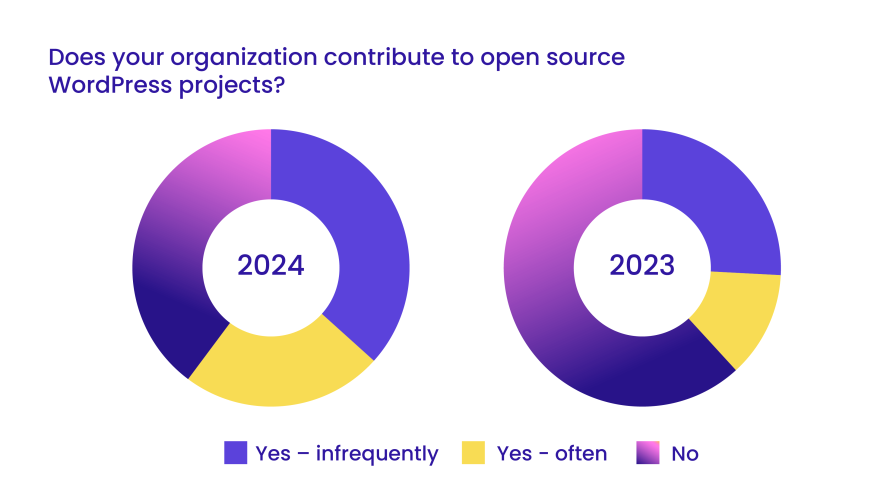Filters
Content Type
Topics
WordPress Statistics and Platform Insights
As the world’s most popular content management system (CMS), WordPress powers a massive number of all websites globally, shaping the way businesses and individuals create, manage and deliver content online. From its humble beginnings as a blogging platform to becoming a powerful tool for enterprises, WordPress has continually evolved to meet the needs of users at all levels.
But lots has changed since its inception, with the rise of headless technologies and newer CMSs starting to gain ground. This naturally leads to many questions, such as: Is WordPress still the best platform to launch a new site on? What about for e-commerce? Higher education? Is it still the best option for enterprises? Which are the must-have themes and plugins?
To answer your questions, we’ve collected together the latest WordPress statistics, trends in themes and plugins and insights into the vibrant WordPress community.
WordPress usage statistics
Quick-fire facts
|
To start off our WordPress Statistics, we have the fact that it powers 43.5% of all websites worldwide, according to W3Techs.
Image

There were 11.9 million searches for “WordPress” in March 2025 (Pantheon original research, April 2025). That’s a 12% year-on-year drop in demand, signaling potential shifts in awareness or market dynamics. However, it remains the dominant platform by a mile.
And, the commercial opportunity remains massive: the traffic value of the top 2,000 WordPress keywords is estimated at $23.2 million per month. Using standard Return On Ad Spend (ROAS) benchmarks, that means these keywords are worth $1.9 billion to $2.8 billion per year to WordPress businesses (Pantheon original research, April 2025).
In e-commerce, WooCommerce – the e-commerce arm of WordPress – takes the top spot, with Shopify right behind it, which has seen a surge in popularity, especially among larger merchants.
WordPress’s reach goes beyond just websites. It’s available in over 200 languages, making it one of the most accessible platforms across the globe!
Themes and plugins statistics for WordPress
As of 2024, the WordPress.org theme repository is home to over 13,000 free themes, offering a wide variety of design options for website owners and developers. This directory includes themes ranging from minimalist designs to feature-rich layouts, all available to the WordPress community at no cost.
An exciting trend within the theme ecosystem is the rise of block themes, which take advantage of the WordPress block editor introduced in version 5.0. In October 2024, the WordPress.org theme repository surpassed a major milestone with over 1,000 block-based themes. This shift toward block themes is indicative of the growing popularity and flexibility of the block editor, allowing users to build more customizable and dynamic websites directly from the editor.
WordPress plugins continue to be a core component of the platform's success, with thousands of options available for everything from SEO optimization to social sharing and, of course, analytics.
For instance, the WP Statistics plugin, known for its privacy-focused approach, has been downloaded over 600,000 times. This plugin offers webmasters a reliable alternative to Google Analytics, giving them insights into website traffic without relying on external services and ensuring compliance with GDPR regulations.
WordPress community statistics
WordPress’s global reach is reflected in its vibrant community events. Since the first WordCamp in 2006, over 1,300 WordCamp events have been hosted across more than 70 countries. These locally organized conferences bring together users, developers and business leaders to share knowledge and foster collaboration.
Community contribution remains strong. In the most recent major release, WordPress 6.6, 38% of contributors were first-timers. This steady influx of new contributors demonstrates the project's accessibility and its ability to continually grow its contributor base.
On the enterprise side, organizations are increasingly investing in open-source contributions. According to the State of Enterprise WordPress 2024 survey, 61% of enterprise respondents reported contributing to open-source WordPress projects, marking a significant increase from 38% in the previous year. This signals a growing trend of enterprise-level users giving back to the platform they rely on.
Image

How WordPress has developed
WordPress has evolved significantly since its launch in 2003. The introduction of the Gutenberg block editor in WordPress 5.0 (2018) transformed content creation by allowing users to build content with a flexible, block-based system. This change simplified workflows for teams, especially in enterprise environments.
WordPress has also adapted to modern web technologies, integrating the REST API to support headless and decoupled architectures. This allows businesses to deliver content across various platforms, such as mobile apps and IoT devices.
Enterprise-focused features like multisite capabilities, advanced user role management and enhanced security protocols have further strengthened WordPress’s role as a strong CMS for large organizations.
Along with this, WordPress is now used as an application framework, powering systems like the scholarly publishing platform Annotum and mobile-enabled ePortfolio systems in enterprise settings like Charité – Universitätsmedizin Berlin, showing just how flexible it can be.
Who knows what we’ll see over the coming years, but we know that WordPress will continue to innovate and adapt to the evolving needs of its users!
Transform your WordPress website with Pantheon
Pantheon’s enterprise solutions are designed to address the growing demands of WordPress users, making sure you have up to 99.99% uptime and 10x faster content delivery. With dev, test, live environments, teams can effortlessly integrate popular plugins and themes without workflow holdups.
For example, Wheaton College saw a doubling of productivity after migrating to Pantheon, thanks to its advanced automation and workflows. They also benefited from Pantheon’s Autopilot feature that further reduced maintenance time, allowing the team to focus on high-value projects instead.
Want to try it for yourself? Explore how Pantheon’s platform can elevate your WordPress experience and meet your enterprise needs today!


